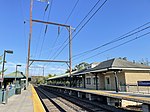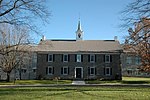Hope Lodge (Whitemarsh Township, Pennsylvania)
American Revolutionary War sitesHistoric American Buildings Survey in PennsylvaniaHistoric house museums in PennsylvaniaHouses completed in 1750Houses in Montgomery County, Pennsylvania ... and 4 more
Houses on the National Register of Historic Places in PennsylvaniaMuseums in Montgomery County, PennsylvaniaNational Register of Historic Places in Montgomery County, PennsylvaniaPennsylvania in the American Revolution

Hope Lodge is a historic building located at 553 South Bethlehem Pike in Fort Washington, Pennsylvania, in the United States. This mansion has been described as "one of the finest examples of Georgian Colonial architecture in this part of the country. It was used by Continental troops during the 1777 Philadelphia Campaign during the American Revolution.
Excerpt from the Wikipedia article Hope Lodge (Whitemarsh Township, Pennsylvania) (License: CC BY-SA 3.0, Authors, Images).Hope Lodge (Whitemarsh Township, Pennsylvania)
South Bethlehem Pike,
Geographical coordinates (GPS) Address Nearby Places Show on map
Geographical coordinates (GPS)
| Latitude | Longitude |
|---|---|
| N 40.124996 ° | E -75.216758 ° |
Address
South Bethlehem Pike 679
19034
Pennsylvania, United States
Open on Google Maps







